Human Rights and Detention: Asylum Seeker Children in Australia
VerifiedAdded on 2022/12/05
|8
|1898
|274
Report
AI Summary
This report analyzes the mandatory detention of asylum seeker children in Australia, exploring its historical development, current legislative frameworks, and human rights implications. It examines the international and national legal frameworks, including the Universal Declaration of Human Rights and the Convention on the Rights of the Child, and evaluates their impact on the detention of children seeking asylum. The report addresses the issues faced by detained children, such as abuse, trauma, and lack of parental support. It also assesses the impact of these detentions on social work, advocating for social justice and human rights. The report concludes with a discussion of the challenges and ongoing developments in this area, highlighting the need for improved implementation of human rights standards and the protection of vulnerable children. The report also covers the case study of the detention of asylum seeker children in Australia.

Running Head: DETENTION OF CHILDREN SEEKING ASYLUM IN AUSTRALIA
CASE ANALYSIS OF MANDATORY DETENTION OF CHILDREN SEEKING
ASYLUM IN AUSTRALIA
CASE ANALYSIS OF MANDATORY DETENTION OF CHILDREN SEEKING
ASYLUM IN AUSTRALIA
Paraphrase This Document
Need a fresh take? Get an instant paraphrase of this document with our AI Paraphraser

DETENTION OF CHILDREN SEEKING ASYLUM IN AUSTRALIA
Introduction and Background
The United Nations High Commissioner for Refugees (UNHCR) states that 25 million
children currently have been uprooted from their homes worldwide (Zion, Briskman & Loff,
2010). There is mandatory detention for the asylum seekers, who arrive unauthorized in
Australia. This includes adults as well as children, who seek asylum while the processing by the
Department of Immigration and Multicultural and Indigenous Affairs (DIMIA) takes place. The
detention of children in these asylums has raised a considerable amount of debate and criticism.
The number of children detained in Australia fluctuates with the asylum seeking
population. While most children are accompanied by adults, only a handful of children detainees
are unaccompanied. The DIMIA Women and Children in Immigration Detention webpage
provides that there is a decreasing number of children in immigration detention facilities in
recent times due to decrease in authorized sea and air arrivals in Australia, increase in number of
persons being released from immigration detention and minors who have turned adults in
detention centers (Martinez et al, 2015). In the mandatory detention of children, they are often
faced with abuse, trauma, unhealthy conditions, self-harm, and no parental support. There are a
number of international and local frameworks that aim at child protection and prevention of these
issues. In the current scope of discussion the historical advancement in the current Australian and
international human rights regimes, with evaluation of the legislative frameworks, institutional,
procedural mechanisms present for enforcement of human rights and such right’s impact on
social work for the purpose of advocating of social justice and human rights has been analyzed.
Historical development of current Australian and international human rights regimes
2
Introduction and Background
The United Nations High Commissioner for Refugees (UNHCR) states that 25 million
children currently have been uprooted from their homes worldwide (Zion, Briskman & Loff,
2010). There is mandatory detention for the asylum seekers, who arrive unauthorized in
Australia. This includes adults as well as children, who seek asylum while the processing by the
Department of Immigration and Multicultural and Indigenous Affairs (DIMIA) takes place. The
detention of children in these asylums has raised a considerable amount of debate and criticism.
The number of children detained in Australia fluctuates with the asylum seeking
population. While most children are accompanied by adults, only a handful of children detainees
are unaccompanied. The DIMIA Women and Children in Immigration Detention webpage
provides that there is a decreasing number of children in immigration detention facilities in
recent times due to decrease in authorized sea and air arrivals in Australia, increase in number of
persons being released from immigration detention and minors who have turned adults in
detention centers (Martinez et al, 2015). In the mandatory detention of children, they are often
faced with abuse, trauma, unhealthy conditions, self-harm, and no parental support. There are a
number of international and local frameworks that aim at child protection and prevention of these
issues. In the current scope of discussion the historical advancement in the current Australian and
international human rights regimes, with evaluation of the legislative frameworks, institutional,
procedural mechanisms present for enforcement of human rights and such right’s impact on
social work for the purpose of advocating of social justice and human rights has been analyzed.
Historical development of current Australian and international human rights regimes
2
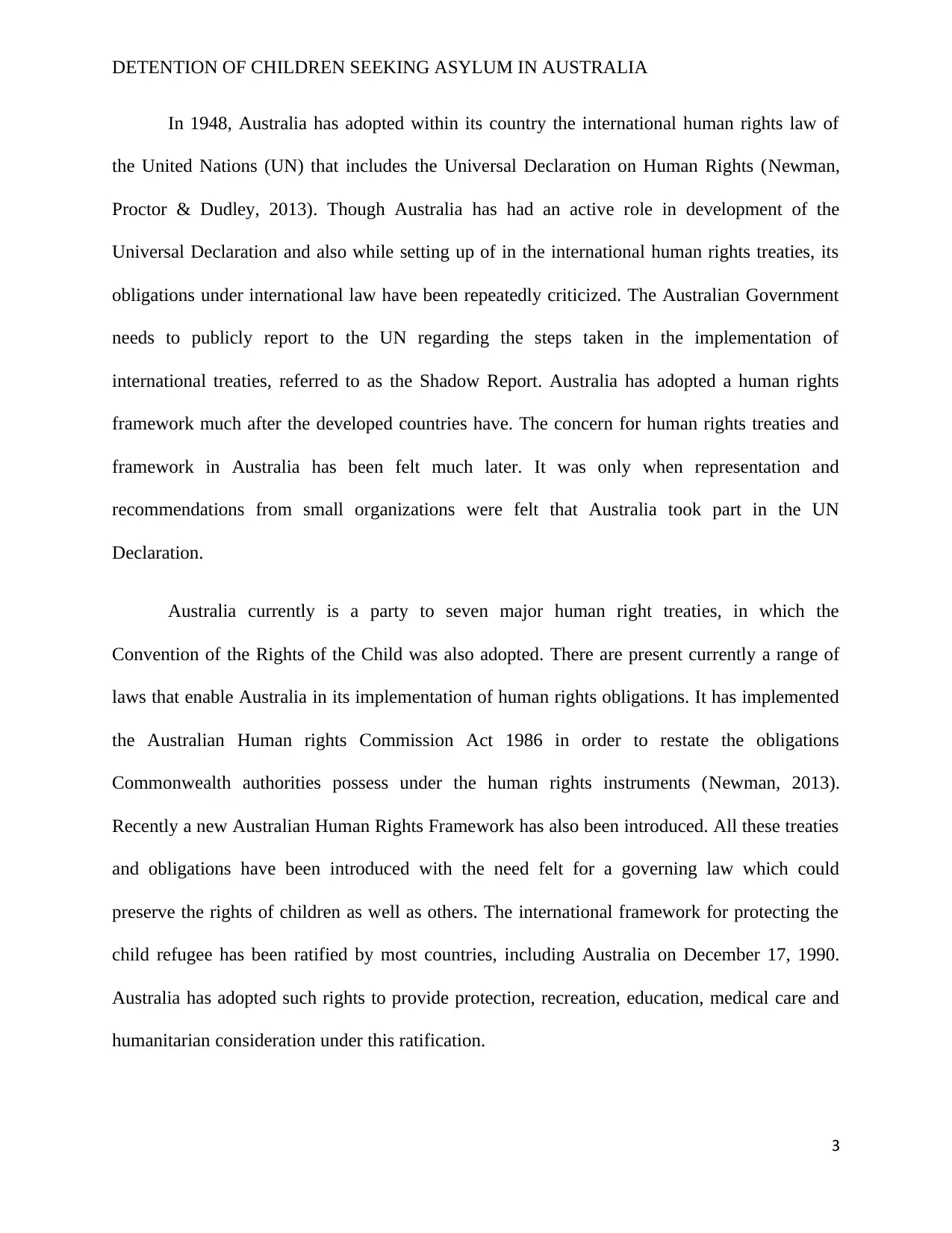
DETENTION OF CHILDREN SEEKING ASYLUM IN AUSTRALIA
In 1948, Australia has adopted within its country the international human rights law of
the United Nations (UN) that includes the Universal Declaration on Human Rights (Newman,
Proctor & Dudley, 2013). Though Australia has had an active role in development of the
Universal Declaration and also while setting up of in the international human rights treaties, its
obligations under international law have been repeatedly criticized. The Australian Government
needs to publicly report to the UN regarding the steps taken in the implementation of
international treaties, referred to as the Shadow Report. Australia has adopted a human rights
framework much after the developed countries have. The concern for human rights treaties and
framework in Australia has been felt much later. It was only when representation and
recommendations from small organizations were felt that Australia took part in the UN
Declaration.
Australia currently is a party to seven major human right treaties, in which the
Convention of the Rights of the Child was also adopted. There are present currently a range of
laws that enable Australia in its implementation of human rights obligations. It has implemented
the Australian Human rights Commission Act 1986 in order to restate the obligations
Commonwealth authorities possess under the human rights instruments (Newman, 2013).
Recently a new Australian Human Rights Framework has also been introduced. All these treaties
and obligations have been introduced with the need felt for a governing law which could
preserve the rights of children as well as others. The international framework for protecting the
child refugee has been ratified by most countries, including Australia on December 17, 1990.
Australia has adopted such rights to provide protection, recreation, education, medical care and
humanitarian consideration under this ratification.
3
In 1948, Australia has adopted within its country the international human rights law of
the United Nations (UN) that includes the Universal Declaration on Human Rights (Newman,
Proctor & Dudley, 2013). Though Australia has had an active role in development of the
Universal Declaration and also while setting up of in the international human rights treaties, its
obligations under international law have been repeatedly criticized. The Australian Government
needs to publicly report to the UN regarding the steps taken in the implementation of
international treaties, referred to as the Shadow Report. Australia has adopted a human rights
framework much after the developed countries have. The concern for human rights treaties and
framework in Australia has been felt much later. It was only when representation and
recommendations from small organizations were felt that Australia took part in the UN
Declaration.
Australia currently is a party to seven major human right treaties, in which the
Convention of the Rights of the Child was also adopted. There are present currently a range of
laws that enable Australia in its implementation of human rights obligations. It has implemented
the Australian Human rights Commission Act 1986 in order to restate the obligations
Commonwealth authorities possess under the human rights instruments (Newman, 2013).
Recently a new Australian Human Rights Framework has also been introduced. All these treaties
and obligations have been introduced with the need felt for a governing law which could
preserve the rights of children as well as others. The international framework for protecting the
child refugee has been ratified by most countries, including Australia on December 17, 1990.
Australia has adopted such rights to provide protection, recreation, education, medical care and
humanitarian consideration under this ratification.
3
⊘ This is a preview!⊘
Do you want full access?
Subscribe today to unlock all pages.

Trusted by 1+ million students worldwide
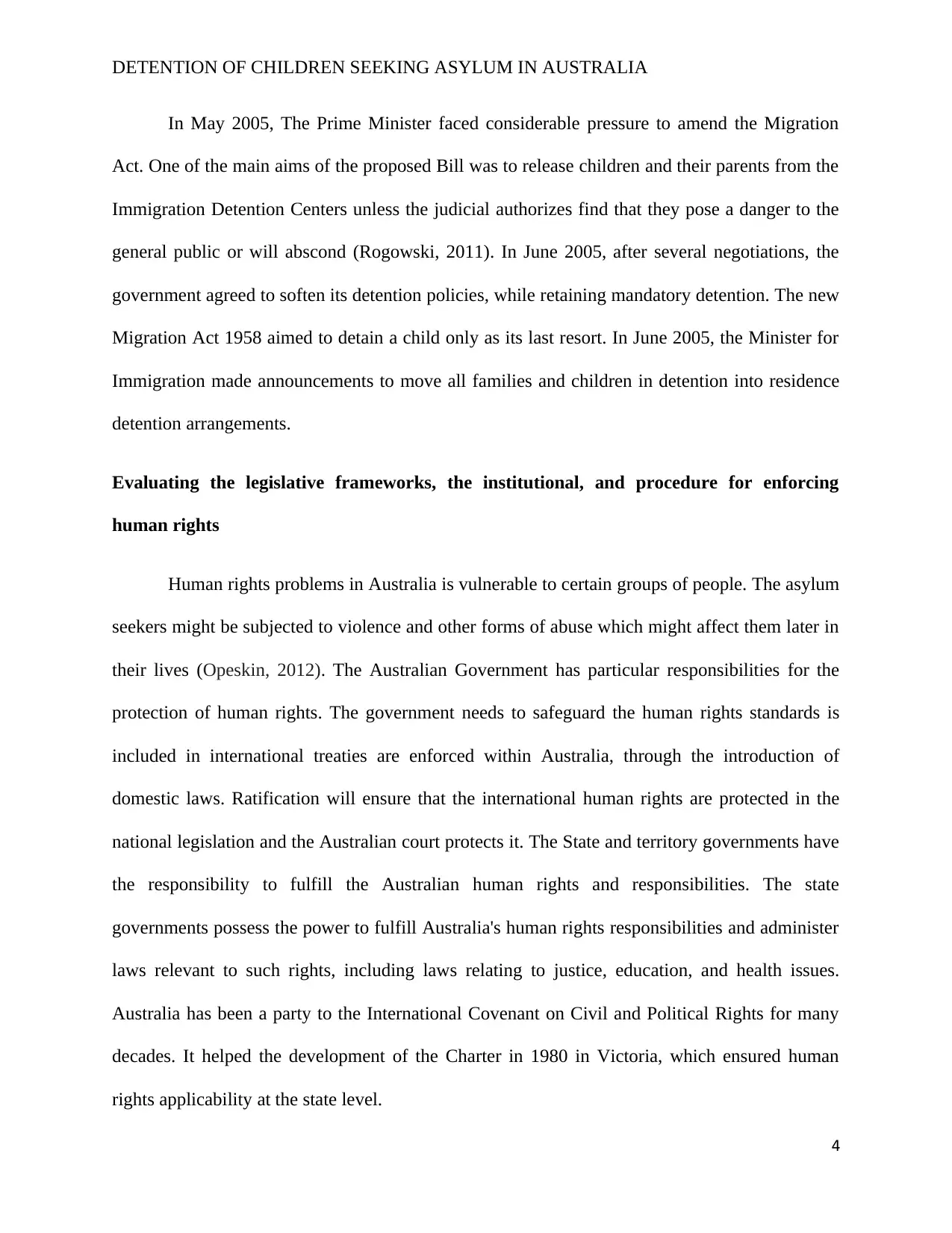
DETENTION OF CHILDREN SEEKING ASYLUM IN AUSTRALIA
In May 2005, The Prime Minister faced considerable pressure to amend the Migration
Act. One of the main aims of the proposed Bill was to release children and their parents from the
Immigration Detention Centers unless the judicial authorizes find that they pose a danger to the
general public or will abscond (Rogowski, 2011). In June 2005, after several negotiations, the
government agreed to soften its detention policies, while retaining mandatory detention. The new
Migration Act 1958 aimed to detain a child only as its last resort. In June 2005, the Minister for
Immigration made announcements to move all families and children in detention into residence
detention arrangements.
Evaluating the legislative frameworks, the institutional, and procedure for enforcing
human rights
Human rights problems in Australia is vulnerable to certain groups of people. The asylum
seekers might be subjected to violence and other forms of abuse which might affect them later in
their lives (Opeskin, 2012). The Australian Government has particular responsibilities for the
protection of human rights. The government needs to safeguard the human rights standards is
included in international treaties are enforced within Australia, through the introduction of
domestic laws. Ratification will ensure that the international human rights are protected in the
national legislation and the Australian court protects it. The State and territory governments have
the responsibility to fulfill the Australian human rights and responsibilities. The state
governments possess the power to fulfill Australia's human rights responsibilities and administer
laws relevant to such rights, including laws relating to justice, education, and health issues.
Australia has been a party to the International Covenant on Civil and Political Rights for many
decades. It helped the development of the Charter in 1980 in Victoria, which ensured human
rights applicability at the state level.
4
In May 2005, The Prime Minister faced considerable pressure to amend the Migration
Act. One of the main aims of the proposed Bill was to release children and their parents from the
Immigration Detention Centers unless the judicial authorizes find that they pose a danger to the
general public or will abscond (Rogowski, 2011). In June 2005, after several negotiations, the
government agreed to soften its detention policies, while retaining mandatory detention. The new
Migration Act 1958 aimed to detain a child only as its last resort. In June 2005, the Minister for
Immigration made announcements to move all families and children in detention into residence
detention arrangements.
Evaluating the legislative frameworks, the institutional, and procedure for enforcing
human rights
Human rights problems in Australia is vulnerable to certain groups of people. The asylum
seekers might be subjected to violence and other forms of abuse which might affect them later in
their lives (Opeskin, 2012). The Australian Government has particular responsibilities for the
protection of human rights. The government needs to safeguard the human rights standards is
included in international treaties are enforced within Australia, through the introduction of
domestic laws. Ratification will ensure that the international human rights are protected in the
national legislation and the Australian court protects it. The State and territory governments have
the responsibility to fulfill the Australian human rights and responsibilities. The state
governments possess the power to fulfill Australia's human rights responsibilities and administer
laws relevant to such rights, including laws relating to justice, education, and health issues.
Australia has been a party to the International Covenant on Civil and Political Rights for many
decades. It helped the development of the Charter in 1980 in Victoria, which ensured human
rights applicability at the state level.
4
Paraphrase This Document
Need a fresh take? Get an instant paraphrase of this document with our AI Paraphraser
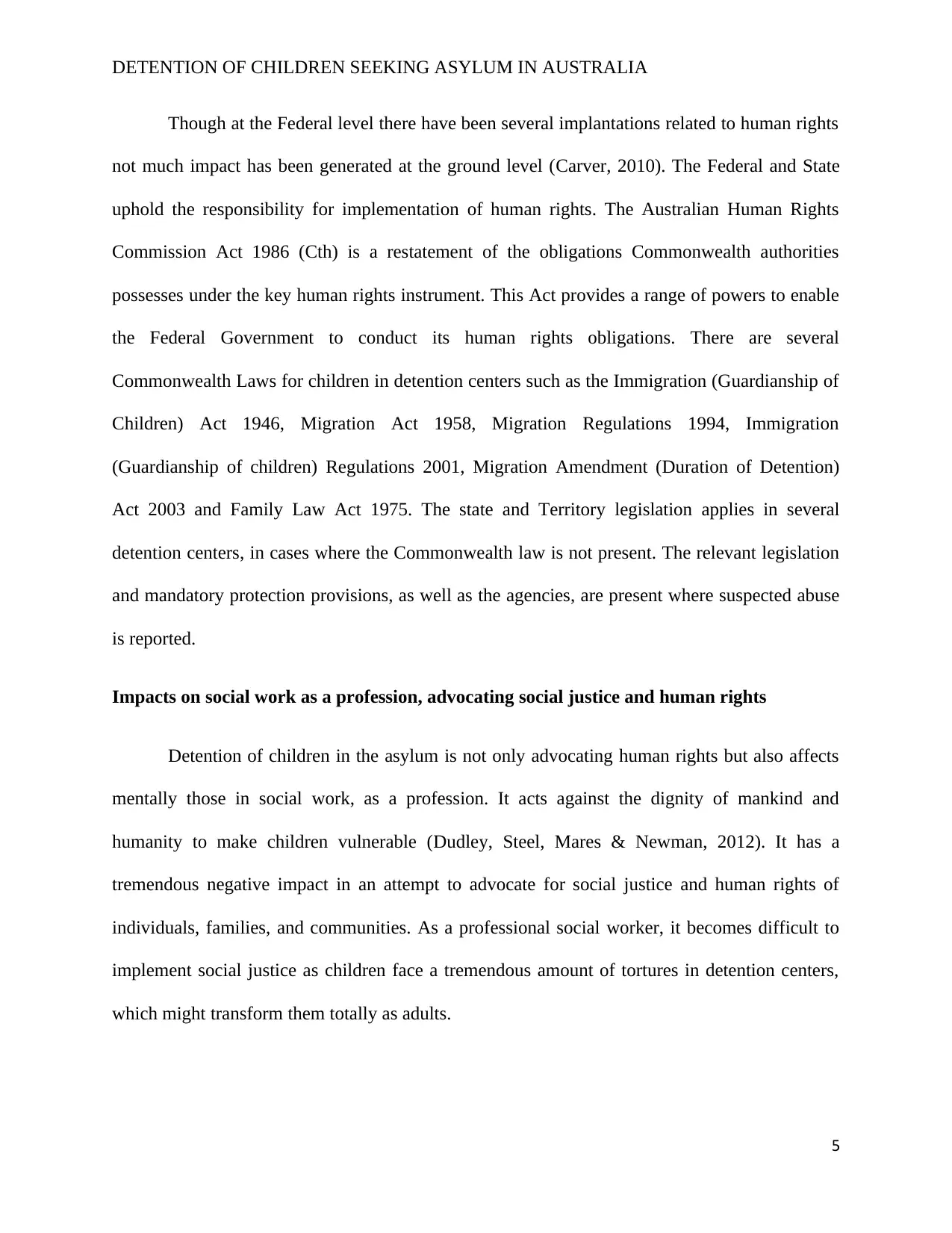
DETENTION OF CHILDREN SEEKING ASYLUM IN AUSTRALIA
Though at the Federal level there have been several implantations related to human rights
not much impact has been generated at the ground level (Carver, 2010). The Federal and State
uphold the responsibility for implementation of human rights. The Australian Human Rights
Commission Act 1986 (Cth) is a restatement of the obligations Commonwealth authorities
possesses under the key human rights instrument. This Act provides a range of powers to enable
the Federal Government to conduct its human rights obligations. There are several
Commonwealth Laws for children in detention centers such as the Immigration (Guardianship of
Children) Act 1946, Migration Act 1958, Migration Regulations 1994, Immigration
(Guardianship of children) Regulations 2001, Migration Amendment (Duration of Detention)
Act 2003 and Family Law Act 1975. The state and Territory legislation applies in several
detention centers, in cases where the Commonwealth law is not present. The relevant legislation
and mandatory protection provisions, as well as the agencies, are present where suspected abuse
is reported.
Impacts on social work as a profession, advocating social justice and human rights
Detention of children in the asylum is not only advocating human rights but also affects
mentally those in social work, as a profession. It acts against the dignity of mankind and
humanity to make children vulnerable (Dudley, Steel, Mares & Newman, 2012). It has a
tremendous negative impact in an attempt to advocate for social justice and human rights of
individuals, families, and communities. As a professional social worker, it becomes difficult to
implement social justice as children face a tremendous amount of tortures in detention centers,
which might transform them totally as adults.
5
Though at the Federal level there have been several implantations related to human rights
not much impact has been generated at the ground level (Carver, 2010). The Federal and State
uphold the responsibility for implementation of human rights. The Australian Human Rights
Commission Act 1986 (Cth) is a restatement of the obligations Commonwealth authorities
possesses under the key human rights instrument. This Act provides a range of powers to enable
the Federal Government to conduct its human rights obligations. There are several
Commonwealth Laws for children in detention centers such as the Immigration (Guardianship of
Children) Act 1946, Migration Act 1958, Migration Regulations 1994, Immigration
(Guardianship of children) Regulations 2001, Migration Amendment (Duration of Detention)
Act 2003 and Family Law Act 1975. The state and Territory legislation applies in several
detention centers, in cases where the Commonwealth law is not present. The relevant legislation
and mandatory protection provisions, as well as the agencies, are present where suspected abuse
is reported.
Impacts on social work as a profession, advocating social justice and human rights
Detention of children in the asylum is not only advocating human rights but also affects
mentally those in social work, as a profession. It acts against the dignity of mankind and
humanity to make children vulnerable (Dudley, Steel, Mares & Newman, 2012). It has a
tremendous negative impact in an attempt to advocate for social justice and human rights of
individuals, families, and communities. As a professional social worker, it becomes difficult to
implement social justice as children face a tremendous amount of tortures in detention centers,
which might transform them totally as adults.
5
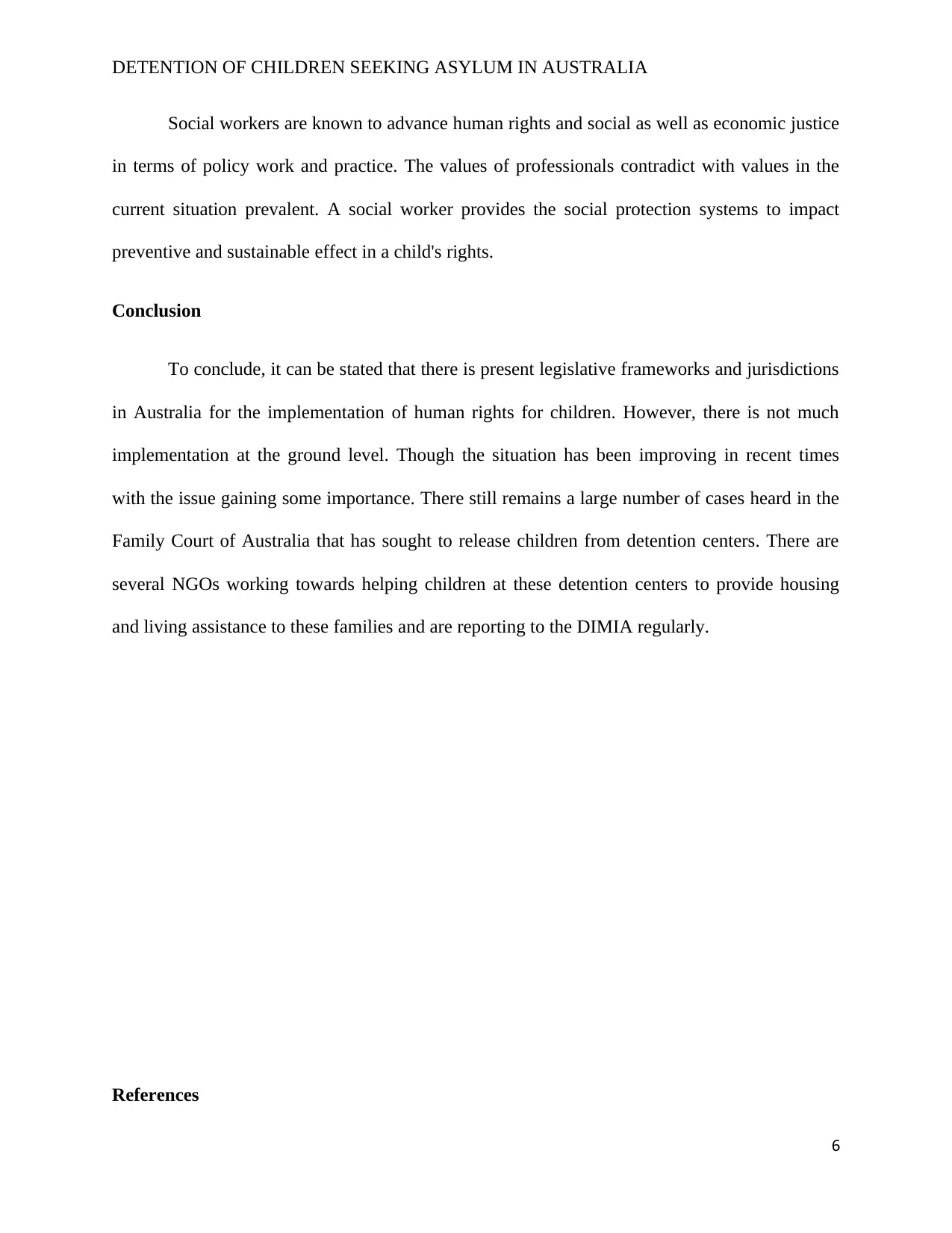
DETENTION OF CHILDREN SEEKING ASYLUM IN AUSTRALIA
Social workers are known to advance human rights and social as well as economic justice
in terms of policy work and practice. The values of professionals contradict with values in the
current situation prevalent. A social worker provides the social protection systems to impact
preventive and sustainable effect in a child's rights.
Conclusion
To conclude, it can be stated that there is present legislative frameworks and jurisdictions
in Australia for the implementation of human rights for children. However, there is not much
implementation at the ground level. Though the situation has been improving in recent times
with the issue gaining some importance. There still remains a large number of cases heard in the
Family Court of Australia that has sought to release children from detention centers. There are
several NGOs working towards helping children at these detention centers to provide housing
and living assistance to these families and are reporting to the DIMIA regularly.
References
6
Social workers are known to advance human rights and social as well as economic justice
in terms of policy work and practice. The values of professionals contradict with values in the
current situation prevalent. A social worker provides the social protection systems to impact
preventive and sustainable effect in a child's rights.
Conclusion
To conclude, it can be stated that there is present legislative frameworks and jurisdictions
in Australia for the implementation of human rights for children. However, there is not much
implementation at the ground level. Though the situation has been improving in recent times
with the issue gaining some importance. There still remains a large number of cases heard in the
Family Court of Australia that has sought to release children from detention centers. There are
several NGOs working towards helping children at these detention centers to provide housing
and living assistance to these families and are reporting to the DIMIA regularly.
References
6
⊘ This is a preview!⊘
Do you want full access?
Subscribe today to unlock all pages.

Trusted by 1+ million students worldwide

DETENTION OF CHILDREN SEEKING ASYLUM IN AUSTRALIA
Carver, R. (2010). A new answer to an old question: national human rights institutions and the
domestication of international law. Human Rights Law Review, 10(1), 1-32. doi :
10.1093/hrlr/ngp040. Retrieved from
https://academic.oup.com/hrlr/article-abstract/10/1/1/602512
Dudley, M., Steel, Z., Mares, S., & Newman, L. (2012). Children and young people in
immigration detention. Current Opinion in Psychiatry, 25(4), 285-292.
doi:10.1097/YCO.0b013e3283548676. Retrieved from https://journals.lww.com/co-
psychiatry/Abstract/2012/07000/Children_and_young_people_in_immigration_detention.
6.aspx
Martinez, O., Wu, E., Sandfort, T., Dodge, B., Carballo-Dieguez, A., Pinto, R., ... & Chavez-
Baray, S. (2015). Evaluating the impact of immigration policies on health status among
undocumented immigrants: a systematic review. Journal of immigrant and minority
health, 17(3), 947-970. doi:10.1007/s10903-013-9968-4. Retrieved from
https://link.springer.com/article/10.1007/s10903-013-9968-4
Newman, L. (2013). Seeking asylum—trauma, mental health, and human rights: An Australian
perspective. Journal of Trauma & Dissociation, 14(2), 213-223. doi:
10.1080/15299732.2013.724342. Retrieved from
https://www.tandfonline.com/doi/abs/10.1080/15299732.2013.724342
Newman, L., Proctor, N., & Dudley, M. (2013). Seeking asylum in Australia: immigration
detention, human rights and mental health care. Australasian Psychiatry, 21(4), 315-320.
doi: 10.1177/1039856213491991. Retrieved from
https://journals.sagepub.com/doi/abs/10.1177/1039856213491991?journalCode=apya
7
Carver, R. (2010). A new answer to an old question: national human rights institutions and the
domestication of international law. Human Rights Law Review, 10(1), 1-32. doi :
10.1093/hrlr/ngp040. Retrieved from
https://academic.oup.com/hrlr/article-abstract/10/1/1/602512
Dudley, M., Steel, Z., Mares, S., & Newman, L. (2012). Children and young people in
immigration detention. Current Opinion in Psychiatry, 25(4), 285-292.
doi:10.1097/YCO.0b013e3283548676. Retrieved from https://journals.lww.com/co-
psychiatry/Abstract/2012/07000/Children_and_young_people_in_immigration_detention.
6.aspx
Martinez, O., Wu, E., Sandfort, T., Dodge, B., Carballo-Dieguez, A., Pinto, R., ... & Chavez-
Baray, S. (2015). Evaluating the impact of immigration policies on health status among
undocumented immigrants: a systematic review. Journal of immigrant and minority
health, 17(3), 947-970. doi:10.1007/s10903-013-9968-4. Retrieved from
https://link.springer.com/article/10.1007/s10903-013-9968-4
Newman, L. (2013). Seeking asylum—trauma, mental health, and human rights: An Australian
perspective. Journal of Trauma & Dissociation, 14(2), 213-223. doi:
10.1080/15299732.2013.724342. Retrieved from
https://www.tandfonline.com/doi/abs/10.1080/15299732.2013.724342
Newman, L., Proctor, N., & Dudley, M. (2013). Seeking asylum in Australia: immigration
detention, human rights and mental health care. Australasian Psychiatry, 21(4), 315-320.
doi: 10.1177/1039856213491991. Retrieved from
https://journals.sagepub.com/doi/abs/10.1177/1039856213491991?journalCode=apya
7
Paraphrase This Document
Need a fresh take? Get an instant paraphrase of this document with our AI Paraphraser
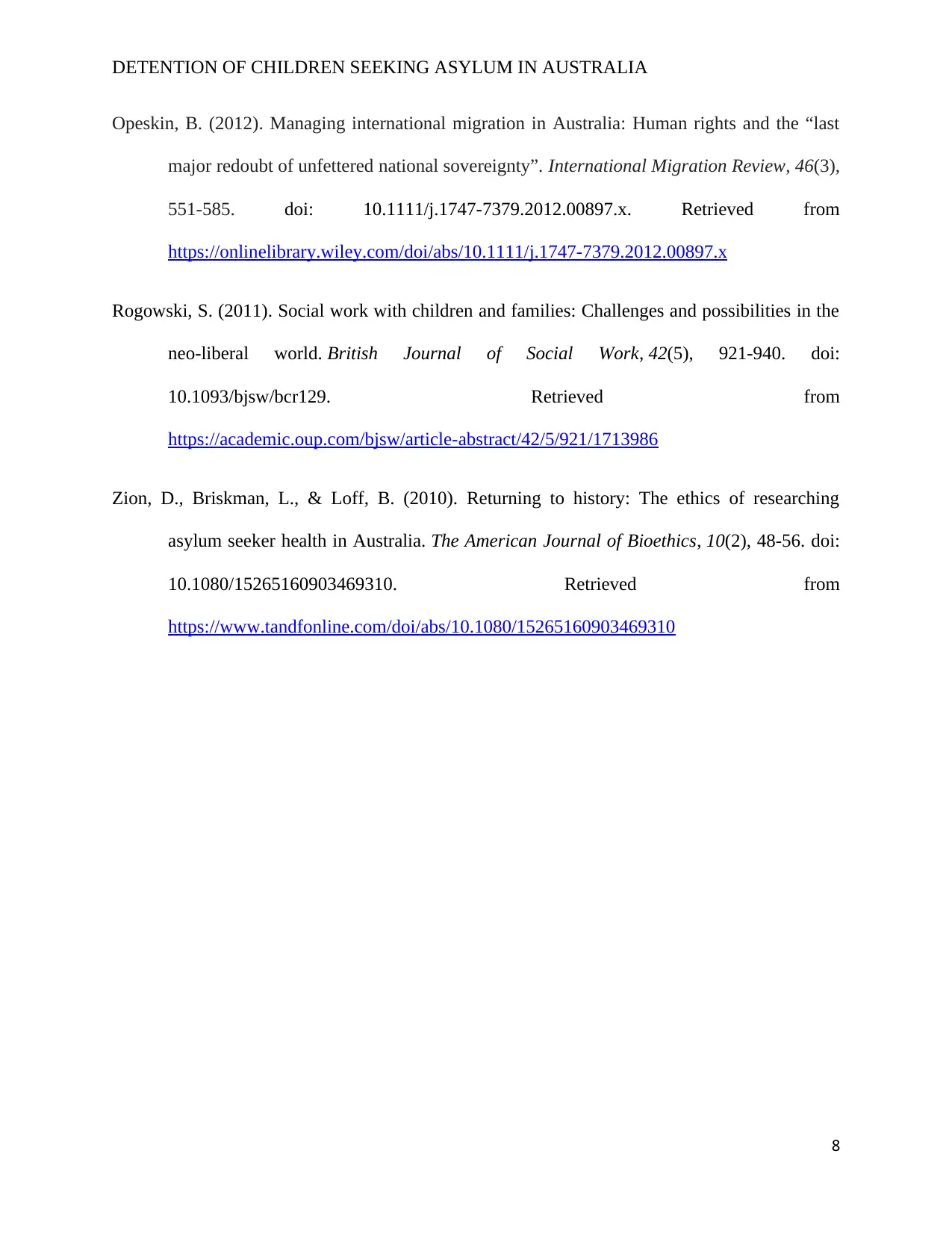
DETENTION OF CHILDREN SEEKING ASYLUM IN AUSTRALIA
Opeskin, B. (2012). Managing international migration in Australia: Human rights and the “last
major redoubt of unfettered national sovereignty”. International Migration Review, 46(3),
551-585. doi: 10.1111/j.1747-7379.2012.00897.x. Retrieved from
https://onlinelibrary.wiley.com/doi/abs/10.1111/j.1747-7379.2012.00897.x
Rogowski, S. (2011). Social work with children and families: Challenges and possibilities in the
neo-liberal world. British Journal of Social Work, 42(5), 921-940. doi:
10.1093/bjsw/bcr129. Retrieved from
https://academic.oup.com/bjsw/article-abstract/42/5/921/1713986
Zion, D., Briskman, L., & Loff, B. (2010). Returning to history: The ethics of researching
asylum seeker health in Australia. The American Journal of Bioethics, 10(2), 48-56. doi:
10.1080/15265160903469310. Retrieved from
https://www.tandfonline.com/doi/abs/10.1080/15265160903469310
8
Opeskin, B. (2012). Managing international migration in Australia: Human rights and the “last
major redoubt of unfettered national sovereignty”. International Migration Review, 46(3),
551-585. doi: 10.1111/j.1747-7379.2012.00897.x. Retrieved from
https://onlinelibrary.wiley.com/doi/abs/10.1111/j.1747-7379.2012.00897.x
Rogowski, S. (2011). Social work with children and families: Challenges and possibilities in the
neo-liberal world. British Journal of Social Work, 42(5), 921-940. doi:
10.1093/bjsw/bcr129. Retrieved from
https://academic.oup.com/bjsw/article-abstract/42/5/921/1713986
Zion, D., Briskman, L., & Loff, B. (2010). Returning to history: The ethics of researching
asylum seeker health in Australia. The American Journal of Bioethics, 10(2), 48-56. doi:
10.1080/15265160903469310. Retrieved from
https://www.tandfonline.com/doi/abs/10.1080/15265160903469310
8
1 out of 8
Related Documents
Your All-in-One AI-Powered Toolkit for Academic Success.
+13062052269
info@desklib.com
Available 24*7 on WhatsApp / Email
![[object Object]](/_next/static/media/star-bottom.7253800d.svg)
Unlock your academic potential
Copyright © 2020–2025 A2Z Services. All Rights Reserved. Developed and managed by ZUCOL.




